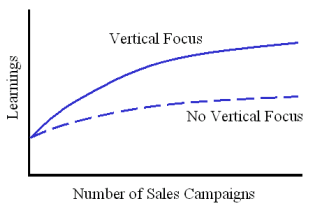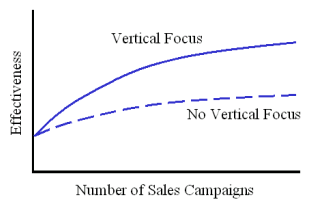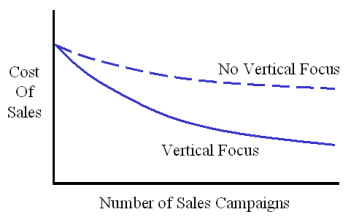|
|
| Home - Industry Article - Dec 06 Issue |
Vertical Marketing Works – The Numbers Prove It |
By Olin Thompson, Principal, Process ERP Partners
We see product companies, service providers, and even hardware companies making public statements about their vertical strategy, focusing their efforts on a specific type of industry, for example banks, steel mills, or bakeries. All too often, the word vertical is an empty statement with little real action behind it. Often, their vertical strategy is more ‘press release-ware’ or ‘power point-ware’. For others, the question remains: why vertical? For both, let us look at why a vertical strategy is a good strategy, looking at the numbers.
Of course, every company wants to look at the numbers that count the most: revenue and expenses. Increasing revenue and decreasing costs are the results of an effective vertical strategy. Verticals allow us to increase our win rate by increasing revenue as well as decreasing the cost of sales.
Knowledge is Power
The benefits of a vertical strategy are immense. For example, a vertical strategy can open new doors to where there may be less competition. Brand recognition is easier to establish in a specific industry. Members of a specific industry give more credibility to their peers, making references, case studies, and media more effective. Fewer product management trade-offs exist when a product is aimed at a specific market. On the revenue side, customers are often willing to pay a little more for an industry-specific program supported by people with industry-specific experience.
A major benefit of a vertical strategy is effectiveness in sales and marketing. With every sales campaign, whether we win or lose, we gain experience and knowledge. We learn about our product, we learn about the prospect’s industry, business, and people. This experience and knowledge are available in all sales campaigns, which take place later on. The question is how much can we benefit from what we have learnt?

Taking an extreme position, with no vertical focus, no two sales campaigns involve the same industry. What we learn about our products may help, but only in a generic, non-industry specific way. We derive limited or no value from what we learn about this campaign’s industry, business, and people.
When we win with no vertical focus, we have a potential reference but one which has limited value. A savings and loan is not a great reference for a steel mill; a sporting goods retailer is also not a great reference for a ski resort.
However, with a vertical focus, each sales campaign contributes to our base of knowledge that will help us with future campaigns. Product knowledge reveals how our product can better serve specific needs, or how best to present a product feature.
Industry knowledge becomes the basis for future discussions, examples, and war stories. For example, many industries have their own vocabulary that everyone in the industry uses instinctively. Specific government regulations are part of many industry scenes, so much so that people just assume a certain level of understanding. What we learn about a company and its people contributes to our understanding of the personality of the industry. Most industries have a ‘personality’, which is common throughout the industry. Some are very conservative; some are aggressive in their spending.
Effectiveness – Experience Counts
When we have a vertical strategy and we engage to win a prospect within that vertical, we have an advantage. If we have no vertical focus, the tables are turned. It is very rare to find a vertical marketplace or a specific deal without at least one vertically focused vendor. If we don’t have vertical focus, we will be at a disadvantage in every sales campaign because it will be extremely rare for us not to be facing a vertically focused competitor.
When we win with a vertical focus, each new customer has the potential to become a reference for all future prospects. A ski resort wants to talk to a ski resort, an apple juice processor to an apple juice processor. The closer we can match what the prospect thinks he is, the more credible the reference.
When we become more effective, we increase our ability to win deals. Our win rate goes up because we are doing a better job and we are selling to prospects where we already know their industry, needs, and issues. We have increased credibility with the prospect and we can add value from the point of our first call. With experience, we can do a better job of setting traps for our competition. We can set the bar high, so only we can pass the test.

More Effectiveness Means Lower Cost
What an effective sales and marketing effort means is a lower cost of sales. We take less time learning the needs of a specific prospect, and less time preparing for sales events and can spend more time on the higher impact sales efforts. With better references, we need less time and travel to bring the prospect to the point of closure. With tightly focused marketing programs, we can spend less to get the prospects that have the highest odds of leading to business. With industry case studies, white papers, slide sets, and brochures we can actually spend less time and money selling the prospect. The prospect sees less risk in our solution because they have the proof it works in companies like theirs.

Olin Thompson is Principal of Process ERP Partners. He has over 25 years' experience as an executive in the software industry with roles in general management, sales, marketing, and business development. Olin advises software companies on strategy and tactics in business strategy, sales, and marketing. He is a frequent author and an award-winning speaker on topics of interest to both software industry and end-user companies. For article feedback, contact Olin at ot@olinthompson.com
 

|
|


|

